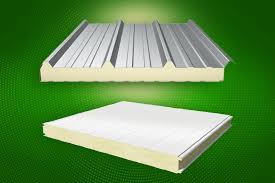 Shree Enterprises
Shree Enterprises
PUF & PIR
❄️ PUF & PIR Insulation
PIR (Polyisocyanurate) and PUF (Polyurethane Foam) are two types of insulation materials commonly used in the construction industry. While both are types of foam insulation, there are some key differences between them
PUF (Polyurethane Foam) and PIR (Polyisocyanurate Foam) are rigid foam insulations widely used for thermal insulation in buildings, cold storage, HVAC, and industrial systems. Known for their high insulation values, lightweight structure, and excellent moisture resistance, they are among the most energy-efficient insulation materials available.
Chemical Composition
PIR and PUF are both made from similar chemicals, but with some differences in their ratios. PIR insulation is made from polyisocyanurate foam, which is a type of rigid foam insulation, while PUF insulation is made from polyurethane foam.
Insulation Value
PIR insulation generally has a higher insulation value than PUF insulation. This means that PIR can provide greater insulation with a thinner layer, making it a popular choice in situations where space is at a premium.
Fire Resistance
PIR insulation is more fire-resistant than PUF insulation , making it a safer choice in situations where fire risk is a concern.
Moisture Resistance
PIR insulation has better moisture resistance than PUF insulation , making it more suitable for use in damp or humid environments.
✅ Key Features
| Property | PUF | PIR |
|---|---|---|
| Thermal Conductivity | ~0.022–0.028 W/m·K | ~0.020–0.024 W/m·K |
| Operating Temperature | -180°C to +90°C | -180°C to +120°C |
| Fire Resistance | Moderate | Superior (self-extinguishing) |
| Density | 35–45 kg/m³ (can vary by application) | 30–45 kg/m³ |
| Water Absorption | Very Low | Very Low |
| Compressive Strength | High | Higher |
| Life Span | 25–35 years | 30–40 years |
🏗️ Applications
❄️ Cold Storage & Refrigeration
Wall and ceiling panels
Floor insulation
Door insulation
🏢 Building & Roof Insulation
Flat and sloped roofs
Cavity walls
Underdeck insulation
🔧 HVAC & Ducting
Insulated duct panels
Pre-insulated duct systems
🛢️ Industrial Use
LNG, cryogenic and chemical storage tanks
Pipe insulation for chilled or high-temp lines
🔥 PUF vs. PIR Comparison
| Feature | PUF | PIR |
|---|---|---|
| Thermal Performance | Excellent | Better |
| Fire Behavior | Melts, burns slowly | Char-forming, self-extinguishing |
| Dimensional Stability | Good | Excellent |
| Cost | Lower | Slightly higher |
| Use in Cold Storage | Widely used | Preferred for fire-rated systems |
🧯 Fire Safety
PIR has better Class 1/Class 0 fire performance (as per BS 476).
PIR forms a protective char layer when exposed to flame.
Fire-retardant PUF grades are also available.